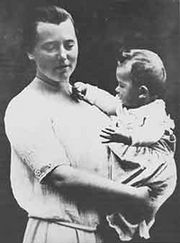Hilde Mangold facts for kids
Quick facts for kids
Hilde Mangold
|
|
|---|---|
 |
|
| Born | 20 October 1898 |
| Died | 4 September 1924 (aged 25) |
| Nationality | Germany |
| Known for | Embryonic induction and the Organiser |
| Scientific career | |
| Fields | Embryology |
Hilde Mangold (born October 20, 1898 – died September 4, 1924) was a German scientist. She studied embryology, which is the study of how living things develop before birth.
Hilde Mangold is famous for her important research in 1923. Her work helped her mentor, Hans Spemann, win the Nobel Prize in 1935. He won the prize for finding something called the "embryonic organizer." This discovery was so important that Hilde's research is one of the few student projects ever to lead directly to a Nobel Prize.
Hilde showed that some cells can tell other cells what to become. This process is called embryonic induction. It's a key idea in how living things grow and develop.
Contents
About Hilde Mangold
Hilde Proescholdt was born in Gotha, Germany, on October 20, 1898. Her father, Ernest Proescholdt, owned a soap factory. Hilde was the middle child of three daughters.
Her Education
Hilde started her studies at the University of Jena in Germany in 1918. She studied there for about a year. Then, she moved to the University of Frankfurt.
While at Frankfurt, she attended a lecture by a famous embryologist named Hans Spemann. This lecture made her want to study embryology even more. After Frankfurt, she went to the Zoological Institute in Freiburg.
Her Family Life
In Freiburg, Hilde met and married Otto Mangold. Otto was Hans Spemann's main assistant. Under Spemann's guidance, Hilde finished her important research.
In 1923, she earned her PhD in zoology. Her research paper was called "Induction of Embryonic Primordia by Implantation of Organizers from a Different Species."
After getting her degree, Hilde moved to Berlin with her husband and their baby son, Christian. Sadly, Hilde died shortly after moving to Berlin. She was badly burned in a gas heater explosion at her home. She never got to see her research published. Her son, Christian, later died during World War II.
Her Amazing Discovery
Hilde Mangold did very careful experiments with tiny embryos. This was especially hard because there were no antibiotics yet to stop infections after surgery.
The Organizer Experiment
She took a small piece of tissue from one newt embryo. This tissue came from a special area called the dorsal lip of the blastopore. She then put this piece of tissue into another newt embryo.
What happened next was amazing! The grafted tissue caused the host embryo to grow an extra body part. It was like creating conjoined twins.
Understanding the Organizer
Hilde used two different types of newts for her experiments. These newts had different skin colors. This allowed her to see that the transplanted tissue didn't form the extra body part by itself. Instead, it told the host embryo's own cells to form the twin.
This showed that the "organizer" tissue could "organize" or direct other cells to develop. This discovery was the basis for understanding how the "organizer" controls a key step in development called gastrulation. Gastrulation is when an embryo starts to form its main body layers.
See also
 In Spanish: Hilde Mangold para niños
In Spanish: Hilde Mangold para niños

